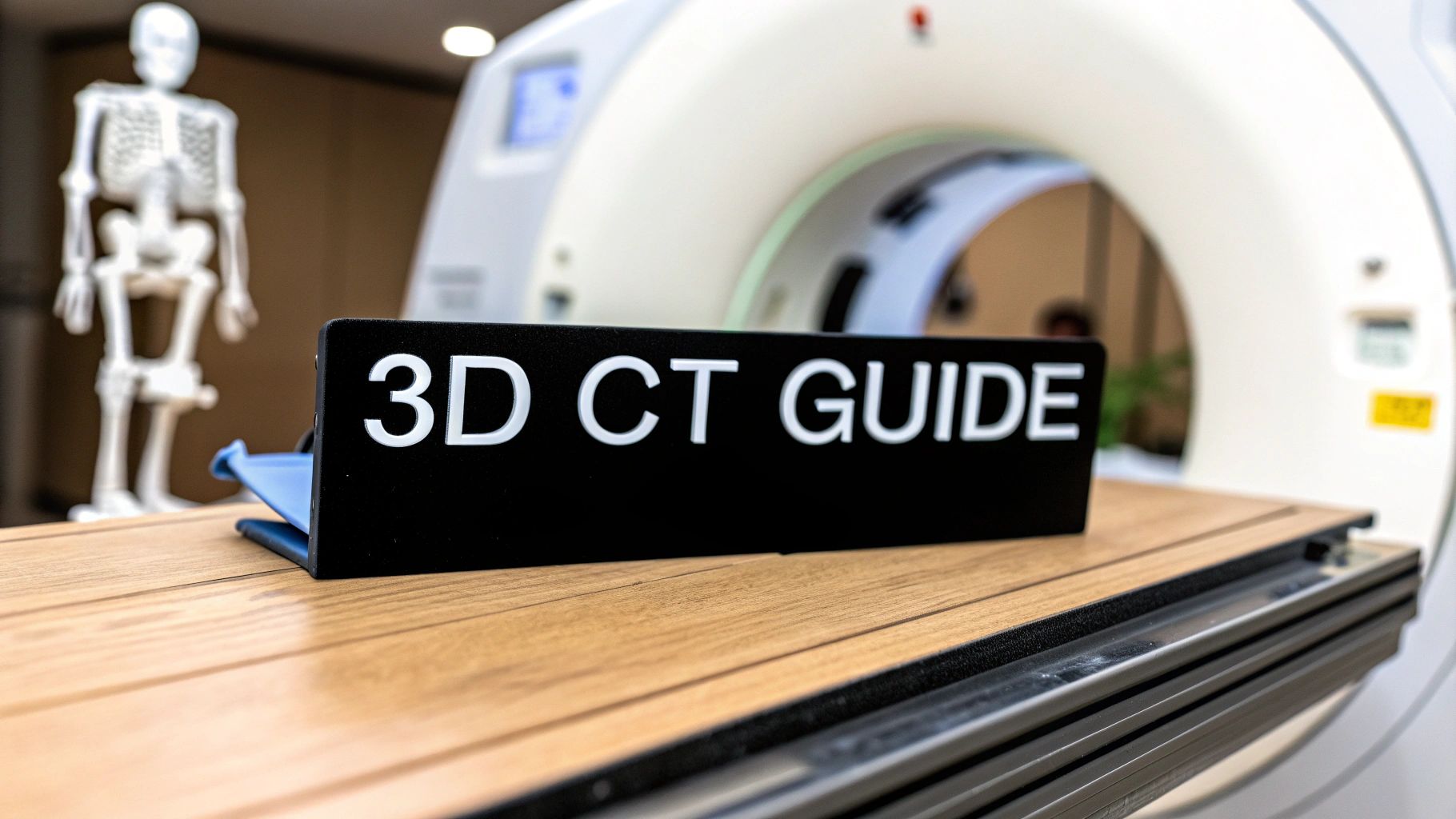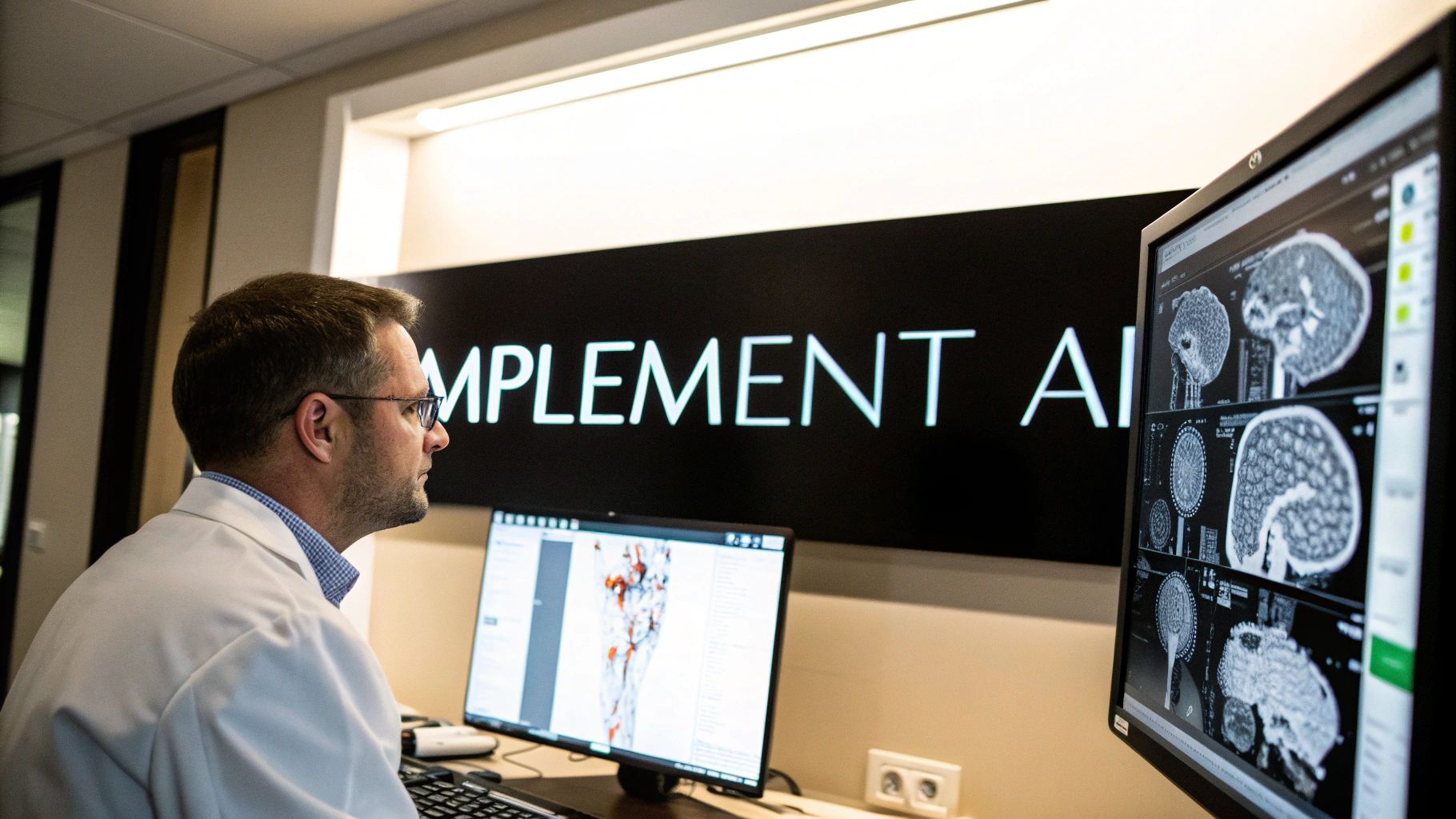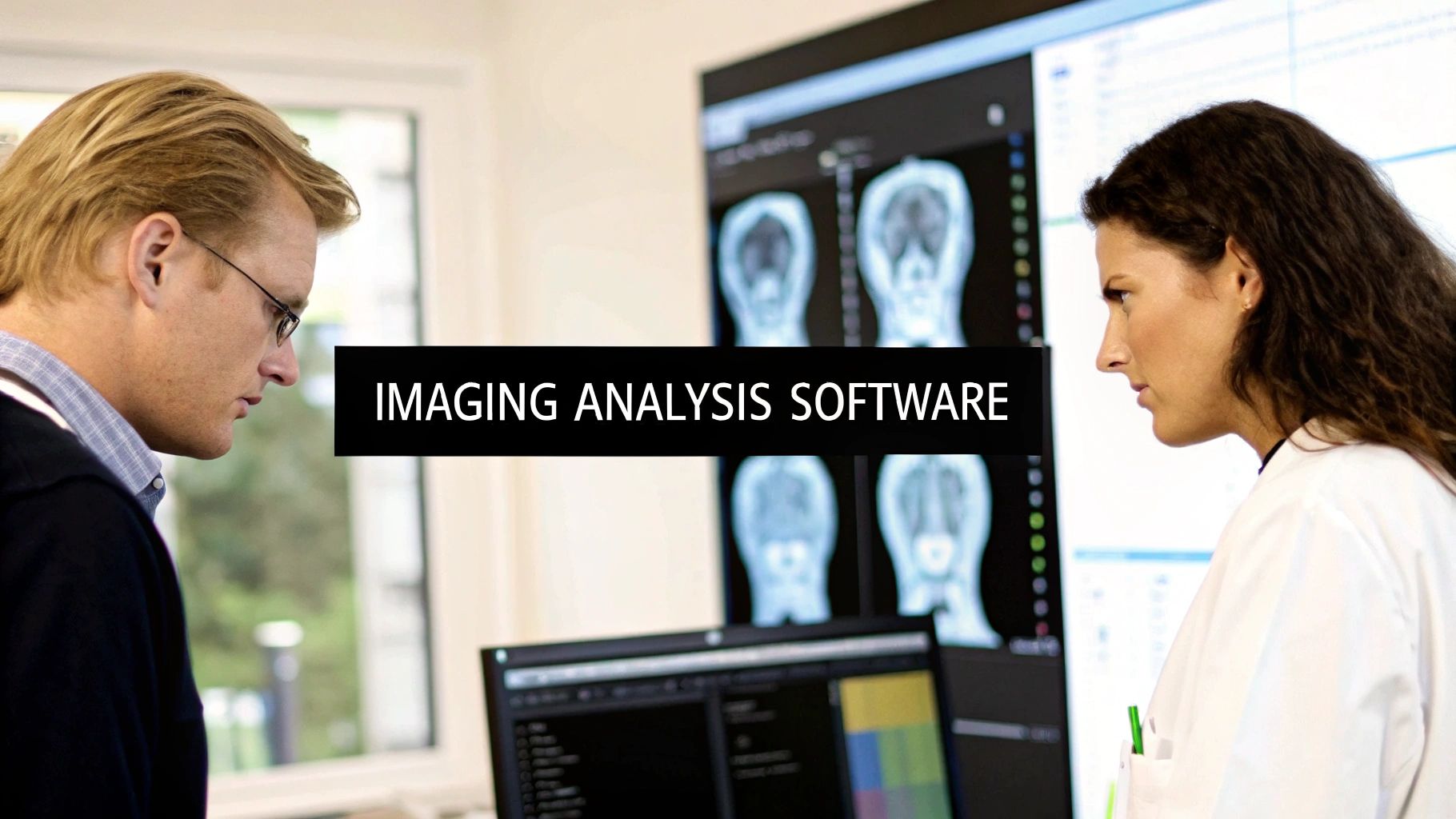The Reality of AI Implementation in Healthcare Today
AI in healthcare is rapidly moving from a futuristic vision to a practical reality, impacting hospitals and clinics globally. This exploration delves into the current state of AI implementation, examining its successes and the hurdles it faces. We'll also uncover the factors driving its adoption and what distinguishes successful implementations from those that stumble.
Current Adoption Rates and Market Growth
The infographic below provides a visual representation of AI's growth trajectory in healthcare. It showcases key data points, including market growth from 2020-2025, hospital adoption rates in 2022, and the projected market value for 2025.
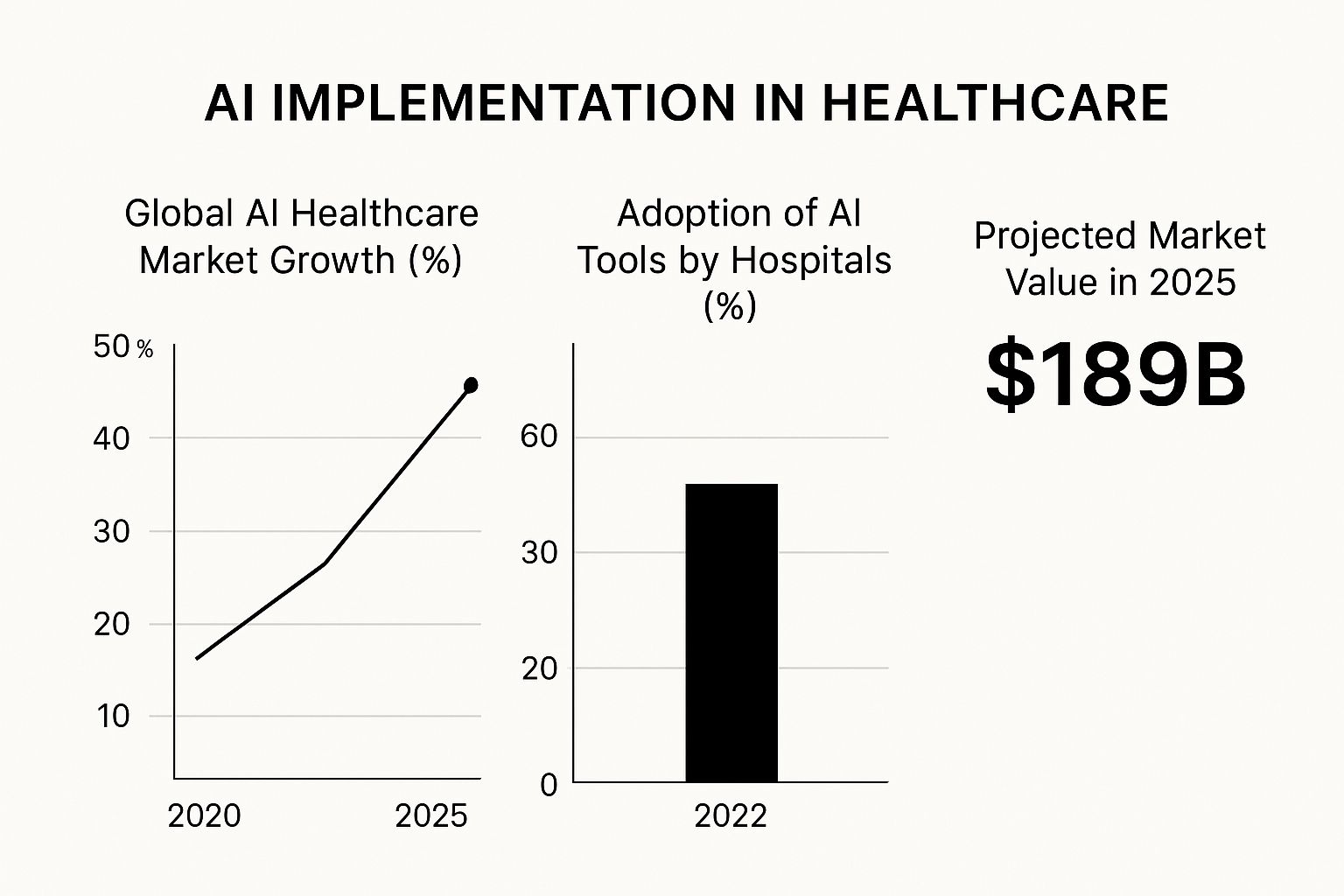
As the infographic illustrates, the AI healthcare market is expanding significantly. Growing adoption rates within hospitals are propelling a surge in market value, emphasizing AI's transformative role in the healthcare sector. The market, having reached $32.34 billion by 2024, is projected to reach a staggering $431.05 billion by 2032. This remarkable growth is fueled by the increasing use of AI in hospitals, with 80% now utilizing AI tools to enhance patient care and streamline operational workflows. For a more detailed look at the statistical landscape of AI in healthcare, you can explore further insights here.
To understand the projected growth and adoption rates, let's examine the following table:
AI Healthcare Market Growth Projections
Market size progression and adoption rates across different healthcare sectors
| Year | Market Size (Billions) | Hospital Adoption Rate | Key Growth Drivers |
|---|---|---|---|
| 2024 | $32.34 | 80% | Increased AI usage in hospitals, focus on personalized care |
| 2032 | $431.05 | Projected to be even higher | Continued advancements in AI technology, expanding applications in various healthcare sectors |
This table highlights the expected continued growth in the AI healthcare market, driven by technological advancements and wider applications.
Driving Forces Behind AI Adoption
Several key forces are accelerating the integration of AI within the healthcare industry.
-
Improved Patient Outcomes and Personalized Care: AI algorithms analyze extensive patient data, identifying patterns and predicting risks, which can lead to earlier diagnoses and more effective, tailored treatments.
-
Addressing Healthcare Professional Shortages: The global shortage of healthcare professionals makes AI-powered solutions a crucial resource. AI can automate administrative tasks, freeing clinicians' time for patient care and helping mitigate staffing shortages. This contributes to improved efficiency across the board.
-
Evolving Patient Expectations: Today's patients are more informed and expect convenient, easily accessible care. AI-powered tools, such as telehealth platforms and virtual assistants, play a vital role in meeting these evolving expectations.
Challenges in AI Implementation
Despite its potential, AI implementation in healthcare is not without its challenges.
-
Data Privacy and Security: Protecting patient data is paramount. Strict adherence to regulations like HIPAA is critical for maintaining patient confidentiality and trust.
-
Integration with Existing Systems: Integrating AI with older legacy systems can be a complex and costly undertaking, requiring substantial investment and technical expertise.
-
Resistance to Change: Hesitation or resistance among medical staff can hinder AI adoption if not proactively addressed through comprehensive training and education programs.
Successfully navigating these challenges requires a strategic approach that considers not just the technology, but also the human and organizational aspects of integrating AI. This includes addressing ethical concerns, effective data management, fostering staff acceptance, and demonstrating a clear return on investment to stakeholders.
Game-Changing AI Applications Transforming Patient Care

Artificial intelligence (AI) is rapidly changing the healthcare landscape, moving from a futuristic concept to a practical tool impacting patient care. This section explores real-world AI applications that are making a significant difference in how we diagnose, treat, and manage diseases.
AI-Powered Diagnostic Imaging: Earlier and More Accurate Detection
AI-powered diagnostic imaging is revolutionizing the field of radiology. This technology assists medical professionals in analyzing medical images, such as X-rays, CT scans, and MRIs, with greater efficiency and accuracy. AI algorithms can identify subtle anomalies often missed by the human eye, enabling earlier diagnoses of serious conditions like cancer, heart disease, and neurological disorders. This early detection is vital for prompt intervention and improved patient outcomes.
Furthermore, AI can automate certain aspects of image analysis. This automation reduces the workload on healthcare professionals, allowing them to dedicate more time to complex cases.
AI-Assisted Surgeries: Enhancing Precision and Minimizing Risks
AI-assisted surgery is another area where AI is making significant strides. These systems provide surgeons with real-time data and guidance during procedures, enhancing precision and minimizing the risk of complications. This technology acts as a highly skilled support system in the operating room, providing an additional layer of expertise.
AI-assisted surgery systems also contribute to pre-operative planning and post-operative care, promoting a more comprehensive approach to surgical treatment. AI is impacting various areas of healthcare, from medical imaging and surgeries to patient monitoring.
The integration of AI in medical imaging is projected to grow at a 26.5% CAGR from 2021 to 2028, highlighting its potential for improved diagnostics. AI-assisted surgeries have the potential to decrease hospital stays by over 20%, resulting in estimated annual savings of $40 billion. More detailed statistics can be found here.
AI-Driven Personalized Medicine: Tailoring Treatment to Individual Needs
AI is also playing a transformative role in personalized medicine. By analyzing patient data, such as medical history, genetics, and lifestyle factors, AI algorithms can facilitate the development of customized treatment plans. This approach allows treatments to be tailored to the specific needs of each patient, maximizing the effectiveness of therapies and minimizing adverse reactions.
Personalized medicine represents a significant departure from the traditional one-size-fits-all approach to healthcare. It promises more targeted and successful treatment outcomes, leading to more specialized and effective care in the years to come.
Building Your AI Implementation Strategy That Actually Works

Strategic planning is essential for successful AI implementation in healthcare. Instead of relying on generic templates, a tailored roadmap that addresses your organization’s specific needs and goals is critical. This section explores proven frameworks used by successful healthcare leaders to assess readiness, secure buy-in, and create realistic timelines for AI implementation.
Assessing Your Organization's AI Readiness
Before implementing AI, a thorough needs assessment is crucial. This helps establish a strong foundation and ensures alignment between AI capabilities and organizational objectives.
This involves several key steps:
-
Identifying Key Pain Points: Pinpoint the specific areas within your healthcare operations where AI can offer the most significant improvements. This could include areas like diagnostic imaging analysis, administrative task automation, or personalized treatment plans.
-
Data Inventory and Evaluation: Determine the availability, quality, and accessibility of data necessary for training and operating AI algorithms. High-quality data is a major factor in the success of any AI initiative.
-
Infrastructure Analysis: Assess your current IT infrastructure to determine if it can support the computational demands of AI. Consider factors like processing power, storage capacity, and network bandwidth.
-
Stakeholder Engagement: Engage with clinicians, IT staff, and administrators early in the process to address concerns, gather input, and build support for AI initiatives.
This foundational work sets the stage for a smoother, more efficient implementation process and increases the likelihood of achieving your AI goals.
Developing a Phased Approach to AI Implementation
A phased approach to AI implementation allows for manageable progress, minimizes disruption to existing workflows, and enables continuous improvement.
This approach typically involves:
-
Pilot Projects: Start with smaller, focused pilot projects to demonstrate the value of AI and gain practical experience before scaling up. A pilot project could focus on a specific imaging modality, a particular administrative task, or a targeted patient population.
-
Iterative Development: Design your implementation process to allow for adjustments based on real-world feedback, performance data, and changing needs. Flexibility and adaptability are key in AI projects.
-
Continuous Monitoring: Track key performance indicators (KPIs) throughout the implementation process to measure progress, identify areas for improvement, and demonstrate the impact of AI. This data provides valuable insights for future phases and informs decision-making.
This phased approach reduces risk and allows for adjustments along the way, maximizing the chances of long-term success.
Aligning AI Initiatives with Clinical Workflows
For AI to be truly effective, it must seamlessly integrate with existing clinical workflows. This requires careful planning and collaboration.
Here are some key considerations:
-
Workflow Analysis: Map out current clinical processes to understand how AI can be best integrated without disrupting operations or adding unnecessary complexity. This involves a detailed examination of existing systems, procedures, and user interactions.
-
Collaboration with Clinicians: Work closely with medical staff to ensure that AI tools are designed to support their needs, enhance their workflow efficiency, and improve patient care. Clinician input is essential for successful integration.
-
Training and Education: Provide adequate training and support to staff on the use and benefits of AI tools. This fosters adoption, promotes proper utilization, and maximizes the effectiveness of the technology.
Proper alignment with clinical workflows is crucial for successful AI integration and ensures that AI tools are used effectively to enhance patient care and improve operational efficiency.
Vendor Evaluation and Technology Selection
Choosing the right technology partner and AI solutions is a critical step in your implementation strategy.
Here’s what you should consider:
-
Needs-Based Selection: Select vendors and technologies that align with your specific organizational needs, clinical goals, and technical requirements. Avoid being swayed by hype and focus on practical solutions that address your specific challenges.
-
Scalability Considerations: Choose solutions that can scale as your organization grows and your AI needs evolve. This forward-thinking approach avoids costly upgrades and ensures long-term compatibility.
-
Integration Capabilities: Ensure the chosen technology integrates seamlessly with your existing systems, including electronic health records (EHRs) and other clinical platforms, to minimize disruption and maximize interoperability. Seamless integration is key to avoiding data silos and ensuring efficient data flow.
A careful vendor selection process ensures that you have the right tools and support for successful, long-term AI implementation.
To help illustrate the various implementation strategies and their associated factors, consider the following comparison table:
AI Implementation Strategy Comparison
Different approaches to healthcare AI implementation with pros, cons, and best use cases
| Implementation Approach | Timeline | Investment Required | Best For | Success Rate |
|---|---|---|---|---|
| Phased Rollout | 12-24 months | Moderate | Organizations seeking to minimize disruption and gain experience incrementally | High |
| Big Bang | 6-12 months | High | Organizations with robust infrastructure and a high tolerance for rapid change | Moderate |
| Hybrid Approach | 18-36 months | Moderate-High | Organizations seeking a balance between speed and stability | High |
This table summarizes three common approaches: phased rollout, big bang, and hybrid. Each approach has its own timeline, investment requirements, ideal use cases, and potential success rate. Choosing the right approach depends on your organization’s specific circumstances. A phased rollout offers a more controlled and gradual implementation, while a big bang approach is faster but riskier. The hybrid approach combines elements of both.
Navigating The Biggest Implementation Roadblocks
Implementing AI in healthcare offers incredible potential, but it also comes with its fair share of hurdles. This section explores some common roadblocks and offers practical solutions for overcoming them.
Data Privacy and Regulatory Compliance
One significant concern is data privacy. Healthcare data is highly sensitive, requiring AI systems to comply with strict regulations like HIPAA. Successful organizations prioritize data security from the start, implementing robust encryption and access control measures. They also collaborate with legal teams throughout the implementation process to maintain continuous compliance.
This proactive approach builds trust with patients and helps avoid potential legal complications. Staying informed about evolving guidelines and adapting AI systems is also crucial for regulatory compliance. This necessitates a commitment to regular monitoring and updates.
Integration With Legacy Systems
Many healthcare organizations rely on older, legacy systems. Integrating AI with these systems can be complex and expensive. A successful strategy involves careful planning and a phased approach to integration.
Starting with smaller pilot projects focused on specific areas allows for a more manageable transition. For example, a pilot project might focus on integrating AI into a radiology department's image analysis workflow before expanding to other areas. This gradual approach minimizes disruption and allows for adjustments based on feedback.
Partnering with experienced technology providers like PYCAD can also streamline this process. PYCAD specializes in integrating AI with medical devices and existing systems, helping bridge the gap between legacy infrastructure and modern AI technology.
Managing Costs and Demonstrating Value
AI implementation requires a substantial investment, and demonstrating a return on investment (ROI) is essential for securing continued funding. One way to manage costs is to focus on areas where AI can have the biggest impact, such as automating administrative tasks or improving diagnostic accuracy.
Demonstrating value involves tracking key metrics and communicating the benefits of AI to stakeholders. This includes quantifying improvements in patient outcomes, cost reductions, and increases in staff efficiency. For example, demonstrating cost savings from reduced hospital readmissions through an AI system can be a compelling argument for continued investment.
Staff Resistance and Training
Introducing new technology can be met with resistance from staff. Addressing this challenge requires a proactive approach centered on training and education. Comprehensive training programs can help staff understand the benefits of AI and how it will affect their roles.
Showcasing success stories and highlighting how AI can improve patient care and workflows can build enthusiasm and create AI champions within the organization. These individuals can then advocate for AI and encourage adoption among their colleagues, fostering a positive environment for smoother implementation.
Navigating these roadblocks requires a comprehensive strategy that addresses technical, financial, and human factors. By prioritizing data privacy, planning for integration, demonstrating value, and fostering staff support, healthcare organizations can unlock the full potential of AI and improve patient care.
Proving ROI and Measuring What Matters in Healthcare AI
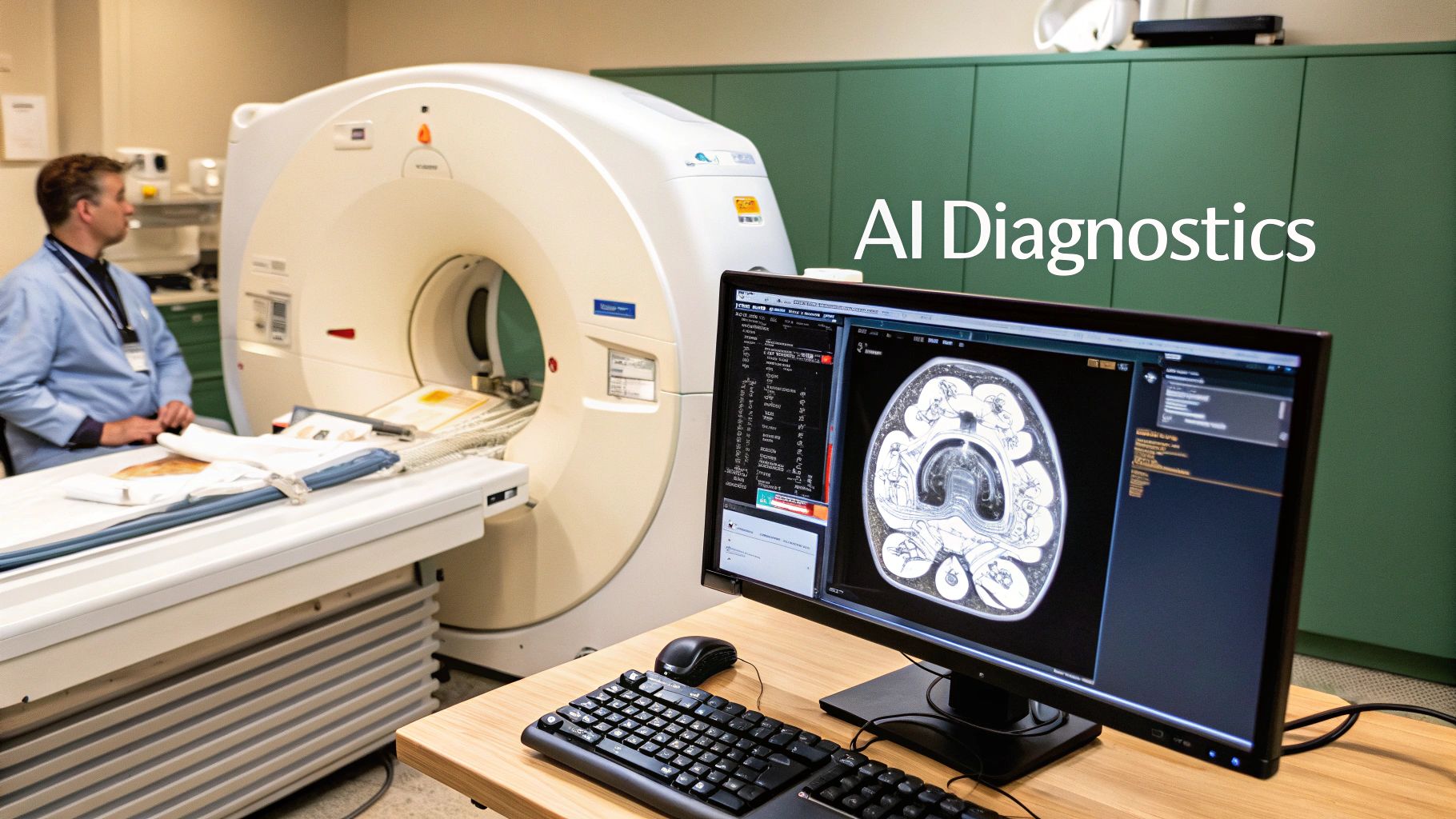
Demonstrating the value of AI in healthcare requires more than just calculating costs. It demands a strategic approach to measuring and communicating its impact on various stakeholders. This involves understanding which metrics resonate with physicians, administrators, and financial officers.
Identifying Key Performance Indicators (KPIs)
The first step in proving Return on Investment (ROI) is identifying the appropriate Key Performance Indicators (KPIs). These KPIs should align with your organization's goals for AI implementation.
For example, if improving diagnostic accuracy is a primary goal, metrics like sensitivity and specificity are essential. However, if operational efficiency is the focus, metrics such as reduced report turnaround time and increased patient throughput become more relevant.
Establishing Baselines and Tracking Progress
Before implementing AI, establish clear baselines for your chosen KPIs. This creates a benchmark for comparing performance after implementation.
For instance, track the average time radiologists take to read a chest X-ray before and after using an AI diagnostic tool. This quantifies time saved and demonstrates increased efficiency. Continuously tracking progress is crucial to showcasing the ongoing value of AI.
Calculating ROI: Beyond Direct Cost Savings
Calculating ROI for healthcare AI involves assessing both direct and indirect benefits. Direct cost savings might include reduced staffing needs or lower operational expenses.
Indirect benefits, though sometimes harder to measure, are equally important. These can include improved patient satisfaction, better staff retention, and a stronger brand reputation. AI-powered personalized treatment plans, for example, can boost patient engagement and satisfaction, leading to better treatment adherence.
Communicating the Value of AI Investment
Communicating the ROI of AI effectively is crucial for securing buy-in and future investment. Tailor your message to different stakeholders, highlighting the metrics most relevant to them. Physicians are interested in improved patient outcomes, while CFOs prioritize cost savings and operational efficiencies.
A compelling business case that showcases both tangible and intangible benefits can justify continued investment in AI. This might involve presenting case studies of successful AI implementations and quantifying the impact on key metrics.
Creating AI-Ready Teams That Embrace Change
Your AI technology is only as good as the people using it. This section addresses the human element of AI implementation in healthcare. We'll explore how leading organizations are bridging skill gaps, training their teams, and building a culture that welcomes innovation.
Identifying and Addressing Skill Gaps
Successfully integrating AI in healthcare requires a workforce capable of using these new tools effectively. This begins with a thorough skills gap analysis. Identify the skills needed to operate, maintain, and interpret results from AI systems.
These might include new roles focused on data science, machine learning, or AI ethics. Once these gaps are identified, organizations can create targeted training programs and recruit individuals with the required expertise. This proactive approach ensures your team is prepared for the demands of AI.
Developing Comprehensive Training Programs
Training is crucial for smooth AI adoption. Develop programs that address the specific needs of different roles. For example, clinicians need training on using AI tools for diagnosis and treatment planning. IT staff, on the other hand, requires expertise in system integration and data management.
These programs should cover both the technical aspects of AI and change management. Addressing staff fears about changing roles is essential. This comprehensive approach equips staff with the knowledge and confidence to embrace AI.
Fostering a Culture of Innovation
Introducing AI often requires changes to workflows and established practices. Fostering a culture that welcomes innovation is key.
This involves promoting open communication about AI's benefits and actively involving staff in the implementation process. Recognizing and rewarding early adopters and “AI champions” can build momentum. Addressing concerns transparently and creating a safe environment for staff to adapt is also crucial. This fosters a positive and supportive transition to AI.
Restructuring Roles and Creating New Career Pathways
AI implementation may lead to changes in existing roles and the creation of new career paths. For instance, radiologists might evolve to include AI-assisted image interpretation, requiring new skills in data analysis and algorithm interpretation. New roles like AI trainers or data quality specialists could emerge.
Organizations should proactively plan for these changes. Creating clear career pathways and providing professional development opportunities is vital. This forward-thinking approach helps maintain morale and ensures your organization attracts and retains top talent in the evolving landscape of AI in healthcare. By preparing effectively, we can maximize AI's benefits while supporting job security and professional growth.
Future-Proofing Your Healthcare AI Investment
AI in healthcare is constantly evolving. A static approach to AI implementation won't suffice in this dynamic environment. This section explores building adaptable strategies that remain effective despite rapid technological advancements and changing regulations.
Staying Ahead of the Curve: Emerging AI Trends in Healthcare
The future of AI in healthcare is brimming with possibilities. Emerging trends like federated learning offer enhanced privacy and collaboration. Federated learning allows AI models to be trained across multiple decentralized data sources without sharing sensitive patient information. Explainable AI (XAI) is also gaining traction, providing insights into the reasoning behind AI-driven diagnoses and treatment recommendations. This transparency increases trust and understanding. Keeping up with these developments is crucial for maintaining a competitive edge and effectively planning future integrations.
Adapting to Regulatory Changes: Ensuring Compliance in a Dynamic Landscape
As AI in healthcare matures, the regulatory environment will also evolve. Staying informed about evolving guidelines, such as those from the FDA regarding AI-enabled medical devices, is paramount. Integrating compliance into your AI implementation strategy from the beginning, rather than addressing it retroactively, will save valuable time and resources. This proactive approach ensures your AI investments remain compliant and sustainable.
Building for Scalability: Planning for Growth and Expansion
Choosing scalable AI solutions is mission-critical. As your organization and data grow, your AI systems must adapt seamlessly. This means selecting technologies and vendors that can handle increasing data volumes and evolving requirements. This foresight avoids costly system overhauls and ensures long-term value from your AI investment. Planning for scalability is, therefore, a core component of future-proofing.
Fostering Strategic Partnerships: The Power of Collaboration
Strategic partnerships are essential for success in the AI healthcare landscape. Collaborations with technology vendors, like PYCAD, provide access to expertise, support, and continuous innovation. These partnerships offer valuable insights into emerging technologies, best practices, and effective implementation strategies, as well as support for integrating AI into existing workflows and optimizing performance.
Maximizing Current Investments: Ensuring Long-Term Value
Future-proofing also involves maximizing the value of your current AI investments. This includes regular system maintenance, ongoing performance monitoring, and continuous improvement based on real-world data and user feedback. Staying up-to-date on updates and advancements related to your existing systems ensures optimal functionality and extends their lifespan.
By focusing on these key areas—staying informed about emerging trends, adapting to regulatory changes, building for scalability, fostering strategic partnerships, and maximizing current investments—healthcare organizations can ensure their AI implementations remain effective and valuable in the ever-evolving landscape of healthcare technology.
Ready to explore how PYCAD can help you integrate AI seamlessly into your medical imaging workflows? Visit PYCAD to learn more.


